Historical and Technical Documentation by John Maidment
© OHTA (last updated June 2011)
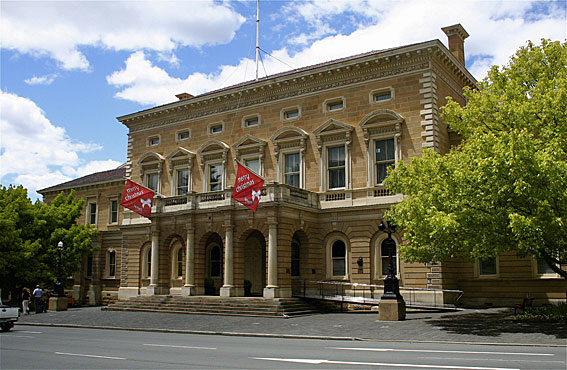
Hobart Town Hall : exterior
[photograph by Trevor Bunning (24 December 2008)]
Historical and Technical Documentation by John Maidment
© OHTA (last updated June 2011)

Hobart Town Hall : exterior
[photograph by Trevor Bunning (24 December 2008)]
This large building, in a florid Italian Classical style, was designed by Henry Hunter and built in 1864-66.1 It is of interest for its symmetrical form and meticulous level of detailing which includes the pediments to the windows of the piano nobile, and a projecting triple-arched portico. The main hall, with elaborate plaster details, is located immediately behind the façade at first floor level.

Hobart Town Hall : interior showing the J.W. Walker organ
and its stencilled facade pipes taken late 19th century
[photograph from Picture Australia]
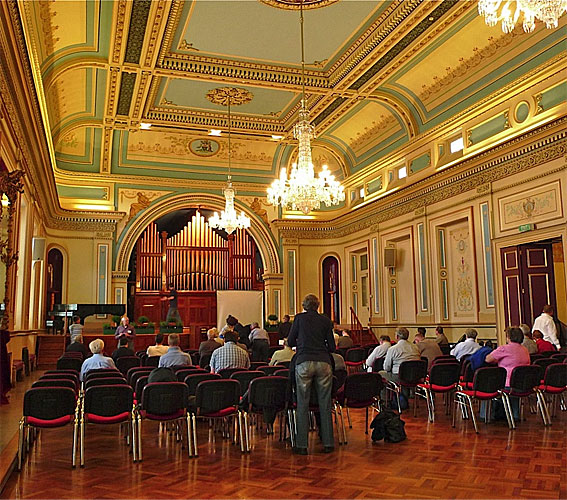
Hobart Town Hall : interior showing the J.W. Walker & Sons Ltd organ
[photograph by Trevor Bunning (26 April 2011)]
The organ was ordered in March 1868 (job number 905) from J.W. Walker & Sons, London.2 It was built under the supervision of Richard Limpus, organist of St Michael's Church, Cornhill. The instrument was installed by Jesse Biggs and opened on 17 March 1870.3 With three manuals and 29 speaking stops, the tonal design was practically identical to the 1865 Walker instrument now in St Stephen's Church, Richmond, Melbourne, except for the addition of a Great Clarion, Choir Clarionet and Pedal Violoncello and Trombone, the latter initially prepared for.
Mr. Packer writes when ordering organ 25 March 1868:
– I cannot again too strongly impress upon you the necessity of avoiding anything screamy or noisy in tone. The Hall is a magnificent room for sound and a noisy Organ would be a perfect abomination in it.
The Soundboards – Tables – Upper Bds. Squares & Backfalls to be of the best seasoned mahogany or wainscot oak.
Composition Pedals & heavy machinery of the best wrought iron & hard wood – I trust particular attention will be paid to this as I have known so many instances in which the compost. Pedals are a nuisance instead of a help. Keys of best Ivory & Ebony – upper sets to project over the lower at least one inch to bring them nearer the performer.
Swell to be Venetian & the Box not less than 2 inches thick & lined. I should be almost disposed to have it a shade thicker if you approve.
The Pipes to be made of extra stout metal to withstand a long voyage & all (except the front ones) to be of the best spotted metal consisting of pure tin & lead only. Rollers for key and Pedal action to be made of wrought iron, with turned centres working in brass bearings bushed with leather for durability and silence.
The Case to be open (as per design submitted & approved), to be deal stained & varnished) with speaking pipes in front decorated. The whole manufacture of the best seasoned materials & in the first style of workmanship. The packing in proper stout cases (delicate parts in tine lines cases).4
An extended account of the instrument was published in March 1870:
The colony – the smallest of the Australian colonies – that some years ago, through a lack of musical talent, had to sell, at a sacrifice, all the instruments belonging to its Choral Society – can now pride itself upon being the possessor of the best organ, with one exception, in the Southern Hemisphere. This great change has been brought about by the perfecting of that native musical talent that was then in a state of positive roughness, and the importation of new blood into our harmonic community ; so that not only is Tasmania now possessed of an organ superior to any in the possession of neighbouring colonies – except New South Wales – but also of a Philharmonic Society that will bear favourable comparison with any other similar society to be found on this side of the equator.
The organ, which now graces the large room of the Town Hall, was ordered some two years ago; and the manufacture of it was entrusted to Mr. J. W. Walker, of London, at a cost of something like £950. Under the superintendence of Mr. Biggs, the instrument has been erected, and able connoisseurs have pronounced the workmanship, tone, and general arrangement to be faultless. As this article is intended only to be descriptive of the organ itself however ; and as a critique appears elsewhere treating upon its "opening" performance, we must be careful to avoid repetition, and confine ourselves to prescribed limits. Turning to the right after mounting the grand staircase, the visitor is presented with a full front view of the organ, the appearance of which is in keeping with the Hall itself, truly superb. Immediately in front of the instrument a temporary platform has been erected, the tiers of seats, three in number, having a rise of about a foot to each tier, the row of seats farthest from the audience being only separated three feet from the organ. The material and workmanship of the organ are described as being of the very best, and there are three complete manual organs – the great, swell, and choir – the compass of each being from CC to G, 56 notes, with an independent pedal organ of three complete stops (a fourth, the trombone, containing 30 pipes, is expected to arrive about Easter), namely from CCC to F tenor, 30 notes. There are 11 stops in the great organ, viz. : bourdon, open diapason, stopt diapason, gamba, wald flute, principal, twelfth, fifteenth, mixture, trumpet and clarion. In the swell organ, there are 10 stops, comprising the following : bourdon, open diapason, stopt diapason, principal, twelfth, fifteenth, mixture, piccolo, oboe, and cornopean. The choir organ has six stops, viz. : stopt diapason, harmonic flute, concert flute, keraulophon, clarionet, and flageolet : whilst the pedal organ has three stops – the open diapason, bourdon, and violoncello, which will be increased at Easter, as before stated, by the addition of a trombone stop recently ordered out of England. Add to these are two and a half octaves of pedals, and five composition pedals. Making these up, the grand total of 1,700 pipes will be found to be at the disposal of the organist ; and if these are not found sufficient to produce sounds enough to satisfy the most fastidious lover of harmony, there must be something altogether wrong in his composition. The organ, which is enclosed in a stained case, and standing 19 feet 6 inches high, 16 feet 6 inches wide, and 16 feet deep, has a rich, evenly-balanced tone, and has been planned with sound judgment, and thorough knowledge of the requirements of an organ specially intended for concert purposes. The great organ, which includes a Gamba and other stops of excellent quality, has eleven through registers. A feature in the swell is the substitution of an orchestral oboe for the ordinary and somewhat indefinite stop of that name. The orchestral oboe of this organ is not too strong and acid to mix well with the other work, but nevertheless has the individual character of the instrument after which it is named. The flutes of the choir organ are of exceptional excellence, and there is a very fine eight-feet violoncello in the pedal organ. Mr. Limpus, under whose superintendence the organ was built, paid particular attention to the adoption of means for the procuring of a most ample supply of wind, so as to suffice for any addition that might be possibly subsequently effected. The apparatus for the supply of wind has been so constructed, that if necessary water-power might be applied to the working of it, and we believe that such is the intention of the committee when opportunity and finds permit of it. The trebles of the stops and open wood pipes instead of being made of deal wood, as is usually the case, have been manufactured out of mahogany, thus ensuring additional durability. The reeds used are of very superior quality : and with a view of preventing the dust from falling in, and preserving them much longer in tune and good order, they have been mitred. Too much praise cannot be accorded to the builder for the introduction into the swell of the orchestral oboe in place of the ordinary oboe stop, so admirably voiced as to serve for solo playing, and yet capable of being used with capital effect in the passages of harmony. The diapasons throughout are very fine, and the flute work on the choir organ is very effective. The vast amount of mechanism used in the instrument is of a first class description, and so simply arranged as to be easily repaired, whilst the arrangements fortuning are also admirably constructed, and ample room is given by passage boards to get at the various parts of the instrument for tuning purposes. The pedal pipes are of a large scale and effective, speaking very promptly, so different to those in use in most organs previously constructed.
In concluding this necessarily brief sketch, we cannot accord too much praise to the gentlemen who were instrumental in procuring this noble instrument for Tasmania. And in doing so express a wish that the Hobart Town Philharmonic Society may enjoy an uninterrupted successful career.5
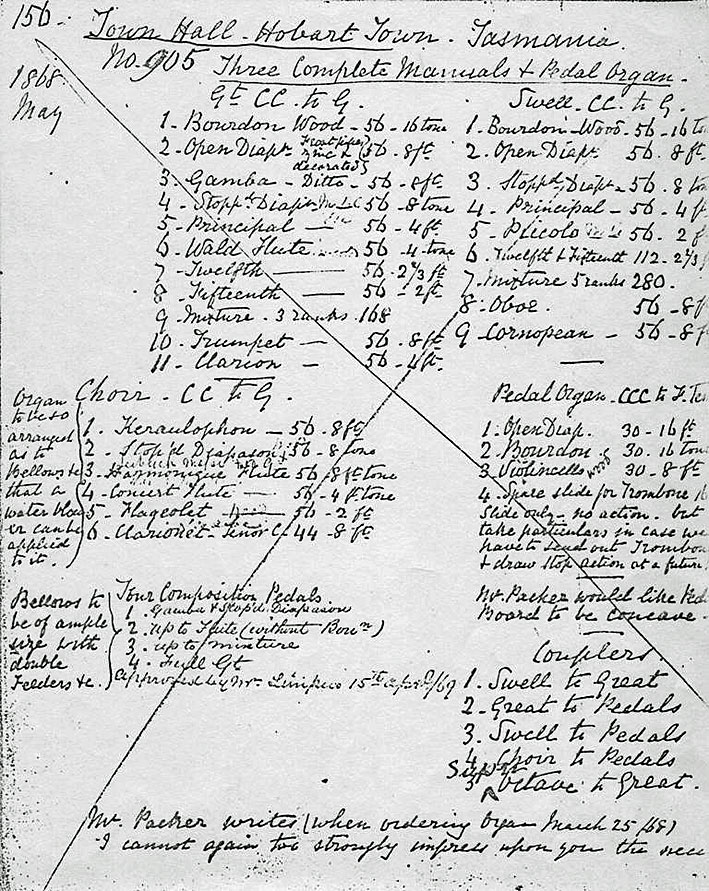

Order record for J.W. Walker organ
(J.W. Walker & Sons Ltd, Brandon, Suffolk, UK)
The specification of the J.W. Walker organ was as follows:
| GREAT Bourdon Open Diapason Gamba Stopped Diapason Principal Wald Flute Twelfth Fifteenth Mixture Trumpet Clarion Swell to Great Super Octave to Great |
CC to G 16 tone 8 8 8 4 4 2-2/3 2 3 ranks 8 4 |
wood front pipes of zinc & decorated ditto metal [treble] wood |
| SWELL Bourdon Open Diapason Stopped Diapason Principal Piccolo Twelfth & Fifteenth Mixture Cornopean Orchestral Oboe |
CC to G 16 tone 8 8 tone 4 2 2-2/3 5 ranks 8 8 |
wood tone metal |
| CHOIR Keraulophon Stopped Diapason Harmonique Flute Concert Flute Flageolet Clarionet |
CC to G 8 8 8 ft tone 4 tone 2 8 |
wood TC |
| PEDAL Open Diapason Bourdon Violincello Spare slide Great to Pedals Swell to Pedals Choir to Pedals |
CCC to F 16 16 tone 8 |
wood for Trombone 16 slide only, no action ... |
Four composition pedals
Organ to be so arranged as to bellows &c that a water blower can be applied to it6
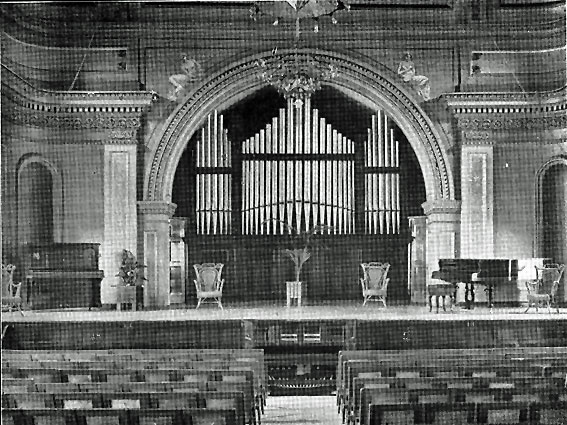
Hobart Town Hall : organ as rebuilt by Geo. Fincham & Sons Pty Ltd
[photograph from Description of The Grand Organ, Town Hall, Hobart,
12th December, 1929: with the compliments of George Fincham & Sons Pty Ltd...]
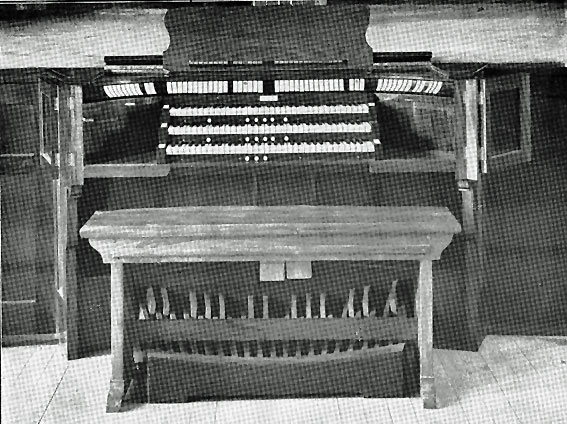
Hobart Town Hall : organ as rebuilt by Geo. Fincham & Sons Pty Ltd - console
[photograph from Description of The Grand Organ, Town Hall, Hobart,
12th December, 1929: with the compliments of George Fincham & Sons Pty Ltd...]
The instrument was rebuilt in 1929 by George Fincham & Sons Pty Ltd, who installed new slider windchests, detached stopkey console and tubular-pneumatic action, increasing the number of stops to 44 and making a new organ case in Tasmanian blackwood, its design copying the original.7 The following tonal changes were made:
GREAT
Addition of Open Diapason no 1 8 on heavy wind and Harmonic Flute 4
SWELL
Addition of Viol d'Orchestre 8, Voix Celeste 8, Wald Flute 4 (from Great), Oboe, Vox Humana and extension of Cornopean to 16 and 4ft pitches to form Double Trumpet 16 and Clarion 4.
CHOIR
Addition of Orchestral Oboe 8 (from Swell)
PEDAL
Violone 16 (extended from Violoncello 8), Principal 8 (extended from Open Diapason 16), Bass Flute 8 (extended from Bourdon 16), Clarion 8 (extended from Trombone 16).
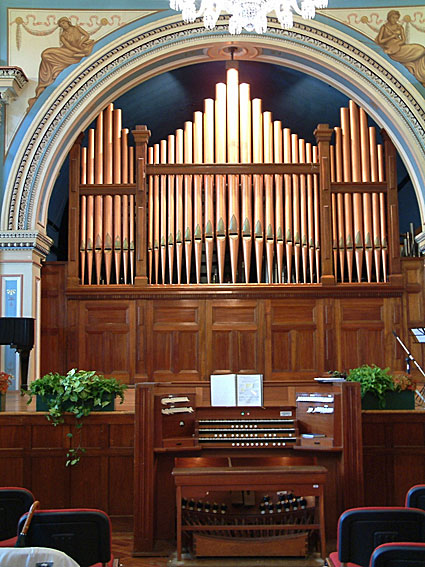
Hobart Town Hall : organ as rebuilt by J.W. Walker & Sons Ltd
[photograph by Pastor de Lasala (3 October 2002)]
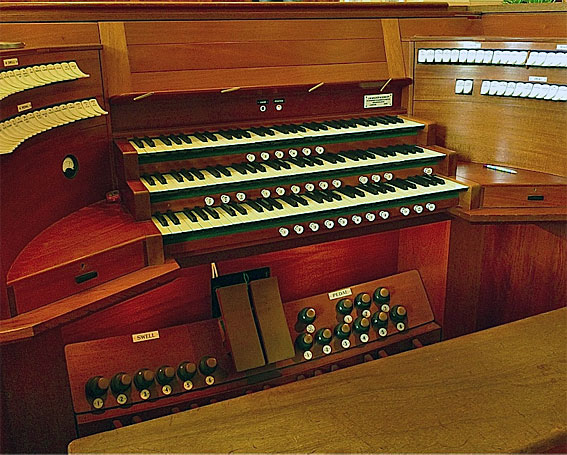
Hobart Town Hall : console by J.W. Walker & Sons Ltd
[photograph by Trevor Bunning (26 April 2011)]
A further rebuild was undertaken in 1966-67 by J.W. Walker & Sons Ltd, of Ruislip, Middlesex, who converted the action to electro-pneumatic and added a new stopkey console as well as carrying out far-reaching tonal changes and additions, including a new floating Positive division. The work was carried out under the direction of Arthur Jones and in consultation with the City Organist John Nicholls.8
| GREAT Violone Open Diapason Viola Stopped Diapason Principal Harmonic Flute Twelfth Fifteenth Mixture 19.22.26 Trumpet Clarion Swell to Great Choir to Great |
16 8 8 8 4 4 2-2/3 2 III 8 4 |
A ex Pedal, new top notes ex Open no 2 ex Gamba (revoiced) remodelled B C |
| SWELL Open Diapason Stopped Diapason Viola da Gamba Voix Celeste Principal Wald Flote Twelfth Fifteenth Piccolo Mixture 19.22.26.29 Contra Fagotto Cornopean Oboe Clarion Tremulant Sub Octave Unison Off Octave |
8 8 8 8 4 4 2-2/3 2 2 IV 16 8 8 4 |
ex Viol d'Orchestre revoiced Ten. C revoiced ex Choir Flageolet remade remodelled D ex Oboe, new bass D new |
| POSITIVE Rohr Flote Principal Koppel Flote Nazard Block Flote Tierce Larigot Sifflote |
8 4 4 2-2/3 2 1-3/5 1-1/3 1 |
(unenclosed) – all pipework new 1967 – playable on bottom manual |
| CHOIR Lieblich Bourdon Salicional Concert Flute Lieblich Gedeckt Salicet Octave Flute Piccolo Orchestral Oboe Clarinet Tremulant Trumpet Clarion Swell to Choir |
16 8 8 8 4 4 2 8 8 8 4 |
(enclosed) E ex Swell & Choir F ex Keraulophon G ex Harmonic Flute E F G G B C |
| PEDAL Open Wood Violone Bourdon Lieblich Bourdon Quint Octave Violoncello Bass Flute Salicional Octave Quint Fifteenth Octave Flute Mixture 22.26.29 Trombone Fagotto Trumpet Clarion Great to Pedal Swell to Pedal Choir to Pedal |
16 16 16 16 10-2/3 8 8 8 8 5-1/3 4 4 III 16 16 8 4 |
A H new top octave E E I ex Open no 1 A H F E I H new part B D B C |
compass: 61/32
electro-pneumatic action
detached stopkey console9
1 Priceless Heritage, p.126
2 J.W. Walker ledger book AA (1868), pp.156-57
3 Re-opening of the Organ in the Town Hall, Hobart, 10th March 1967
4 J.W. Walker ledger book AA (1868), pp.156-57
5 The Mercury, 18 March 1870, p.3
6 J.W. Walker ledger book AA (1868), pp.156-57
7 Description of The Grand Organ, Town Hall, Hobart, 12th December, 1929: with the compliments of George Fincham & Sons Pty Ltd...
8 Re-opening of the Organ in the Town Hall, Hobart, 10th March 1967
9 Ibid.